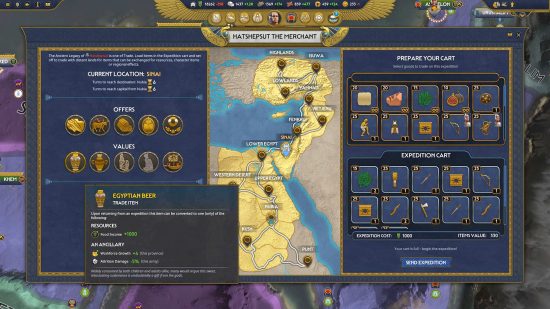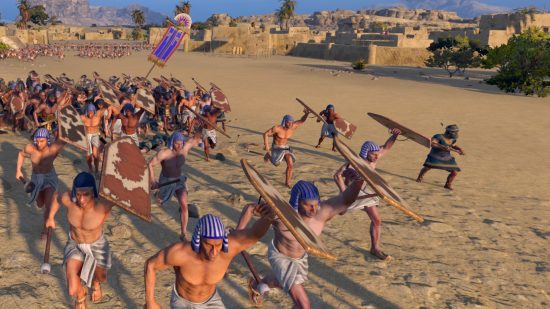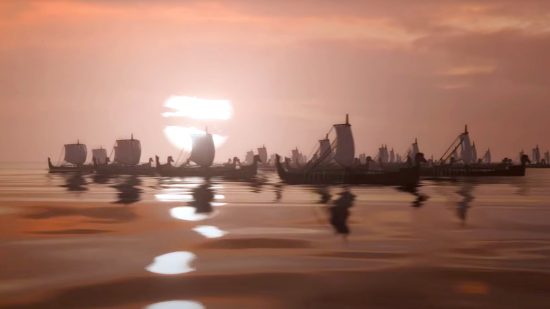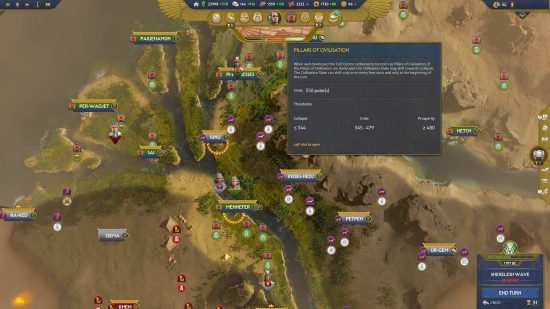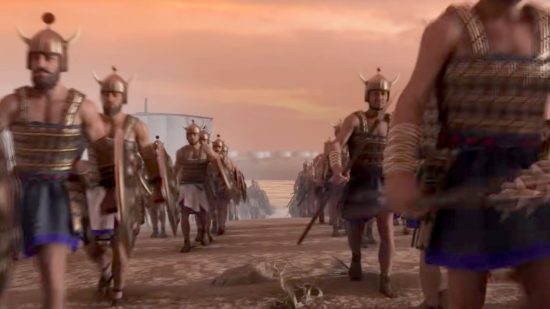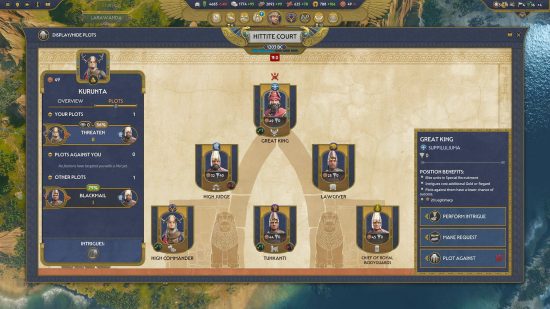Our Verdict
There’s a lot of fun to be had with Total War: Pharaoh, with tons of customization options and genuinely exciting new features offering unique and dynamic ways to complete your campaign. Unfortunately, not all of those features feel fully developed, and the core campaign gameplay is marred by the Sea Peoples’ frustrating influence, leading to a Total War game that’s both good and innovative - but not truly great.
There’s a lot to be said about Total War: Pharaoh. Creative Assembly’s newest offering brings players back to the Bronze Age, at the height of Egypt’s power, just before the Great Collapse shattered the cradle of civilization. Total War Pharaoh grants you a lot of freedom, with copious customizable options and new mechanics that make the campaign much more dynamic than its forebears. That said, it’s held back from greatness by some notable issues, which I’ll detail in this review.
If you love grand strategy games and ancient Egypt, chances are you’ve been eagerly awaiting this one. Read on to find out if Pharaoh is worth your while, and where it places among the best Total War games of all time.
Total War: Pharaoh lets you choose from eight leaders across three distinct cultures: the Egyptians, Canaanites, and Hittites. I picked Ramesses III of Egypt for my first playthrough and, once I’d achieved victory after several dozen turns, I eagerly continued with my campaign to capture more territories and landmarks. Once I was finally sated, I immediately tried out Kurunta of the Hittites for my second run.
In spite of having played every Total War game since the original Rome, I was overwhelmed by all the concepts and ideas in Pharaoh – and it all comes from the array of features that makes each lord feel unique.

For starters, each lord has his or her own unique ability triggered every Shemsu Hor – an annual festival in the ancient world. Ramesses is able to recruit elite Medjay warriors, as well as have his armies attack even when in march stance. Kurunta, meanwhile, gains an army buff that causes fear and bonus rewards when razing settlements.
Speaking of settlements, you’ll manage not just the buildings in the provinces that you own, but also outposts that provide additional perks. There are those that grant extra resource production, favor for worshiping gods, and garrisons that automatically reinforce a nearby city if it’s besieged. Your forces can also interact with these outposts, at times granting handy buffs to movement range and other critical stats.
These fixtures are all seen on a world map that’s rendered in beautiful detail, with imagery evoking designs from hieroglyphs and long-forgotten tablets.
The use of color is particularly striking. At the game’s onset, everything from the Nile Delta in Egypt to the mountainous terrain of Asia Minor is shown in bright, vivid colors, reminding you of the heyday of civilized peoples at the time.
The landscape then gradually becomes muted and darkened, as your territories suffer from the throes of the Bronze Age Collapse (more on this later).
These gradual changes in tone and visual design were astounding. I truly felt that my chosen faction leaders were beacons of hope for that era, only for the stark reality to set in as more challenges assailed me.
The Total War: Pharaoh campaign opens up around turn 12. That’s when you choose between two Royal Traditions: Egyptian or Hittite. From there, assuming your chosen faction has captured a ‘sacred land’ of either culture, you’ll be able to partake in the race for the throne. As such, it’s even possible for someone like Seti or Taurset to become King of the Hittites, or for Kurunta to become Pharaoh of Egypt, whereas the Canaanite lords can swing either way even without owning the aforementioned sacred lands.
As a Total War veteran, I was genuinely impressed by all the features that became available past this stage. For instance, there’s the (initially very impressive) Court system, where I conceived plots to discredit, threaten, or blackmail other characters. This functions somewhat akin to Crusader Kings 3, with you working to increase ‘plot power’ or the success probability of your devious schemes.
Likewise, there’s the Ancient Legacy system, which lets you follow in the footsteps of a magnificent leader from a bygone age. Among the Egyptians, it’s possible to select the legacies of Thutmose, Khufu, Akhenaten, or my first choice, Hatshepsut. A Hatshepsut playthrough gave me a passive means of acquiring more resources, province boosts, and ancillaries – all thanks to the caravans I sent to distant lands.
Conversely, if I chose Khufu’s legacy, I’d have to construct wonders and protect them from encroaching hostiles. The Thutmose route, meanwhile, would have given me options to build up reinforcements before conquering a target settlement. As for the Hittites, they only have two Ancient Legacies: Muwatalli and Tudhaliya. I picked the latter during my Kurunta campaign, which entailed vassalizing other factions and turning my generals into princes to improve relations.
This already chunky strategic toolbox is further bolstered by religion mechanics, where you can worship a total of 19 gods from the Egyptian, Canaanite, and Hittite pantheons. Each deity also provides their own buffs to shrines built in your regions. For example, Ra, Horus, and Moloch are tailored for offensive playstyles, whereas Asherah, Osiris, and Tarhunna provide defensive utility. Moreover, it’s possible to assign a general as a devotee, strengthening them further.
In effect, each new Total War: Pharaoh campaign will be quite unlike your previous run if you decide to choose another Royal Tradition (irrespective of your culture), or a different Ancient Legacy system. These go hand in hand with how you advance in your playthrough, the deities you choose to worship, or how you choose to interact with potential rivals and vassals.
I found these concepts refreshing, as they led to unique and engaging ways to progress. I actually kept saves at certain intervals just so I could reload my run to try and figure out new ways to conquer my neighbors.
As far as battles go, you can expect more of the same, if you’ve played the previous games in the franchise. The crucial thing to be aware of is that, naturally, this is a pretty grounded, historical title. Appropriately to the game’s Bronze Age setting, you’re mostly limited to various types of melee infantry – such as clubmen, axemen, swordsmen, and spearmen.
There are also slingers, archers, and charioteers, which play the role you’d expect – but they’re not as crucial to winning fights as your melee troops. We’re far removed from the era of mounted lancers, war elephants, or artillery, so expect action that heavily focuses on melee slug-fests between loosely organized crowds of angry men.
You can also expect certain changes as combat wears on, from units that falter due to the sweltering heat of the desert, to armor that gradually degrades the more your soldiers stay in the press of close combat. Similarly, generals are accompanied by bodyguards (akin to older historical titles), and aren’t ‘hero’ types that can take or dish out a ton of damage.
Admittedly, I was slightly disappointed. This was mostly because I’ve gotten used to Three Kingdoms, Troy, and Total War Warhammer 3. The lords, or generals, in those games were larger than life, wielding powerful abilities that turned the tide of battle.
In Pharaoh, I really had to readjust to historical realism, leaving those fantastical tropes behind. It’s not a critique, exactly – but a fair warning to anyone who, like me, has become too used to leaders being absolute units on the Total War battlefield.
At the very least, performance in battles met expectations. With an Nvidia RTX 3080, Intel 10900K, and 32GB of RAM, I was able to get around 80 fps at 4K resolution with the highest settings selected.
Regrettably, though, Total War: Pharaoh is not without flaws. Chief among these is how progression is marred by a constant stream of hostiles known as the Sea Peoples. These invaders from across the Mediterranean will swoop into your territories, razing any settlement that they attack.
They’re a feature not a bug, of course – the Sea Peoples were real (if mysterious) invaders, and their incessant raids did help bring about Egypt’s decline. But, historically accurate or not, the way they’re implemented in-game makes them less an extra layer of strategic challenge, and more a repetitive, arbitrary kick in the teeth that can’t be prepared for, or reasoned with.
The Sea Peoples come in waves (pun intended), often in succession, as they’re tied to the Pillars of Civilization mechanic. This concept represents how a series of real-world events and disasters, such as floods on the Nile, earthquakes, drought, and constant warfare led to the Bronze Age Collapse and the decline of Egypt’s rule.
In-game, this is tallied by way of how many intact high-level main buildings remain in Cult Centers across the known world. When things are going well, only a few Sea Peoples come your way; once the Pillars start falling, they return in greater numbers to really ruin your day.
However, it seemed as though I was the only one actually improving my buildings, which I found a bit strange, given that the entire world map is affected by the threats and mishaps that can knock down your Pillars of Civilization score.
To make matters worse, there’s no way to negotiate with Sea Peoples, and they might sail to random locations. I recall how I had crushed an invading army in Amunia in the western coast of the map, only to realize that the next force landed in Ashkelion, well northeast of the Sinai Peninsula. Since the Sea Peoples destroy settlements, they’ll leave you with smoldering, low-level buildings every time, quickly snowballing into further decline.
This intensifying cat-and-mouse game is compounded by the fact that you’re still playing regular Total War on land: your armies will constantly be dealing with hostile factions and rebels that pop up due to low happiness or public order. In short: you’ll be playing 4D Whack-A-Mole as you try to defend your territories.
It’s important to note that you can lower the troop count of the Sea Peoples or even disable them completely, along with rebellions (those are just some of the welcome new campaign customization settings in the game). Still, I opted to play using the default settings, which led to a rather messy affair.
Speaking of messy, there’s the whole civil war for the Pharaoh’s or Great King’s throne to think of. This is depicted in-game via Legitimacy, a value that increases as you win battles, capture settlements, and build key structures.
Once the civil war erupts, those that meet a certain Legitimacy threshold turn into pretenders, all vying to become the next high ruler of the domain.
The downside is that the civil war can get extended for several turns, as new factions hit that Legitimacy value and join the running. At a certain point, I was leading the race as Ramesses, with only one turn left for me to be declared Pharaoh. Suddenly, someone else became a pretender to the throne, which added five more turns.

Eventually, I opted to reload a save a few hours before that moment just to ensure that Ramesses would be crowned swiftly. To be frank, I’d have liked to see a limit placed on the number of pretenders, or an in-game means of preventing extensions, to prevent this sort of not-fun edge case.
I should also note that there were a few minor issues with Pharaoh Powers later in the campaign. The Corvee Labor power, which is supposed to help you construct and repair buildings, doesn’t seem to trigger unless I reloaded my save.
Similarly, the Forced Annexation power only shows a white box when interacting with another faction, and I had to back out to another menu to get it to work. Usual disclaimers about pre-release review code apply, but it’s worth being wary of UI bugs if you pick up Pharaoh at launch.
And, last among the low points, there’s the Court Intrigue feature, which I mentioned earlier as something that seemed impressive at first. It’s simply not fully fleshed out. Although the ministerial positions have their own actions and boons, it quickly devolves into a tedious experience, feeling like I was just going through the motions.
A good example is how every Shemsu Hor, I’d press a couple of buttons while interacting with the Viceroy of Kush, which let me gossip and earn gold. From there, I’d discredit another minister and boost the plot’s success rate. If an NPC was plotting against another officer, I’d simply click on the thumbs up or thumbs down buttons, which lets me increase the regard resource for either of them.
The process was significantly more tiresome when I played as Kurunta, since he only had one action per turn. That meant gossiping and making a request of the Tuhkant, just to receive three actions. Lather, rinse, and repeat, and you’ve got your Court Intrigue system right there. In theory, it’s an engrossing political side mission – in practice, it’s memorizing and repeating a short sequence of button presses, and needs some heavy tweaking to make it more engaging.
To be clear, Total War: Pharaoh is bursting at the seams with refreshing new mechanics, perhaps more so than any of the series’ past historical offerings. You’ve got everything from a Crusader Kings-lite intrigue system and multiple deity benefits, to semi-mythical legacies that change the way you expand your domains.
Sadly, though, it’s just a bit rough around the edges. The core campaign works great, but the implacable, unpredictable onslaught of the Sea Peoples is a little too much, forcing you to spread your forces thinly to meet rival leaders across the map, while playing Whack-A-Mole with countless horde armies that pop up any time, anywhere.
CA gets serious credit for providing new campaign customization tools to amend this bit of the experience, but I reviewed the game on default settings, and those make for a fairly tough time.



